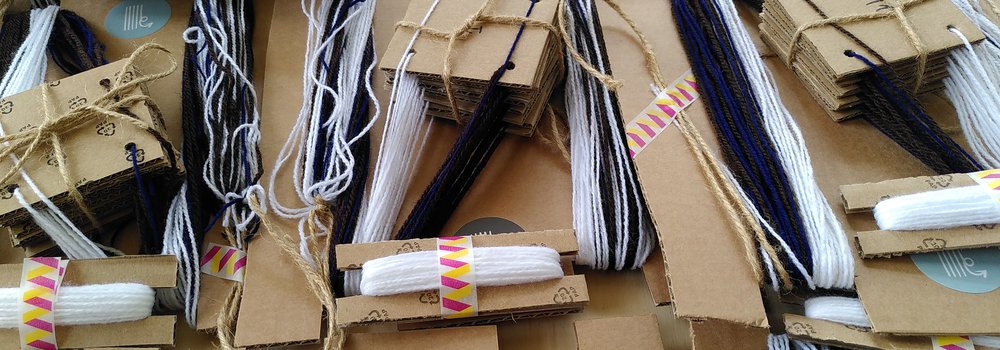Tablet weaving is a perfect way to explore how people have been manipulating digital information for thousands of years. We spent a few days mass producing 25 sets of warps, tablets and shuttles out of cardboard and yarn and dispatched them to Barcelona (via Lizzy Wilson) and Sheffield as part of a remote/hybrid/three location workshop on algorithmic pattern for the on_the_fly_collect(_) festival.
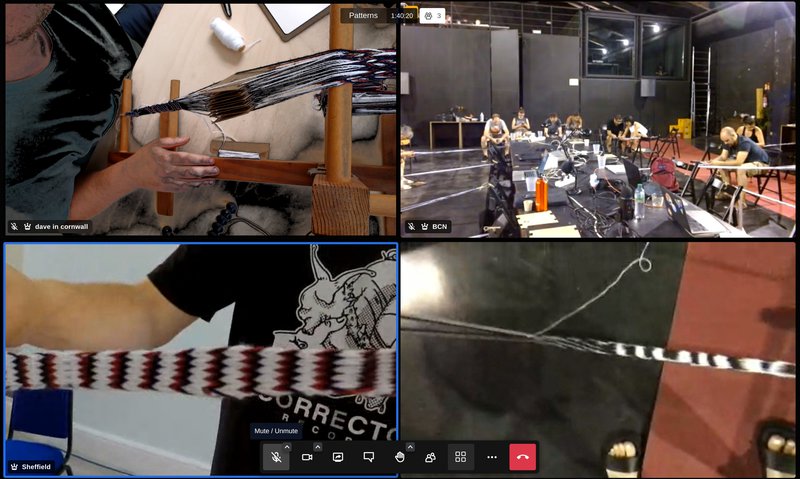
Tablet woven textiles have been found preserved in Iron age salt mines, weaving tablets made out of bone have been found in roman barracks (soldiers were expected to be able to weave their own repairs) and many examples of precious fabric have been found in more recent Viking burials - these all portray a long history of algorithmic pattern manipulation.
The weaving process with tablets involves a seemingly simple combination of rotations of a set of cards that hold (usually four) warp threads each, providing a fixed number of combinations of 'shed' through which you pass the weft threads to weave. You can see this previous post about how to warp your own tablets if you want to try this yourself.
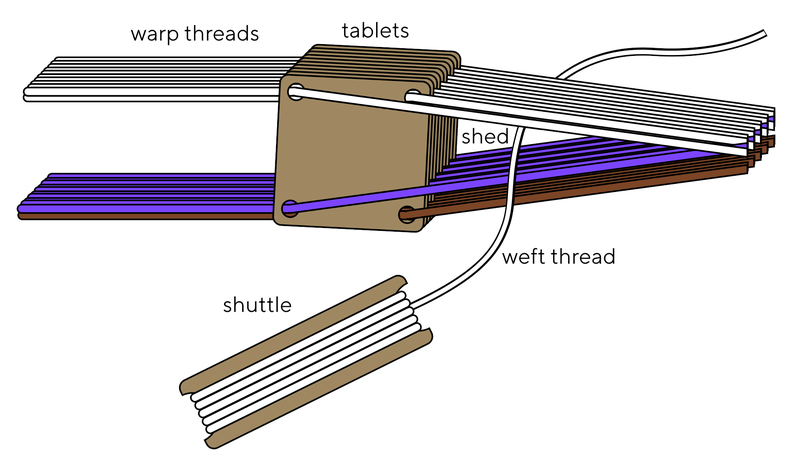
Our aim with this workshop was to highlight how weaving breaks our hard division between all things "digital" and "physical". If we look at the way digital communications work (continuous voltages interpreted as binary values) and compare them with weaving (continuous threads either going above or below each other to form patterns) we see two manifestations of the same underlying process.
In a wider context, it's possible that this confusion is contributing to the seeming lack of ability to effectively use digital technology to make decisions, a fact demonstrated with the leaked photo of the UK's emergency COVID planning "whiteboard".
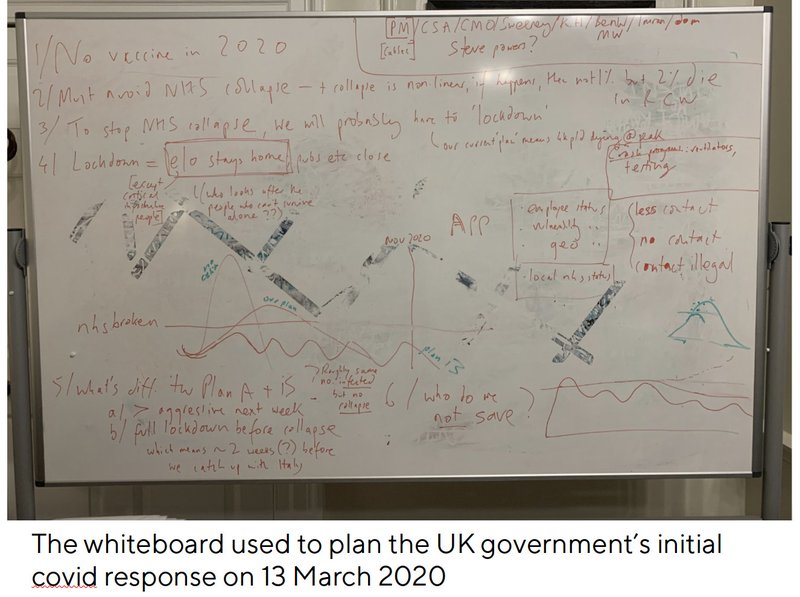
Apparently during this critical meeting the only way the policy makers involved could to look up any information online was using a single smartphone. Although an extreme example, this is a situation that is common in many higher level business settings as well as political ones - we are a very long way from "smart dashboards" and machine learning making decisions for us, especially in places when it's critical and really matters.
I don't think it's simply because policy makers are particularly luddite, but rather that it highlights critical ways our technology is completely unsuitable when, and where the stakes are highest. Part of the reason for this may be because it tends to be specifically designed as if it exists in a universe (or cyberspace) with utterly different rules to the "real" one. Such technology seems hard to trust when it matters.
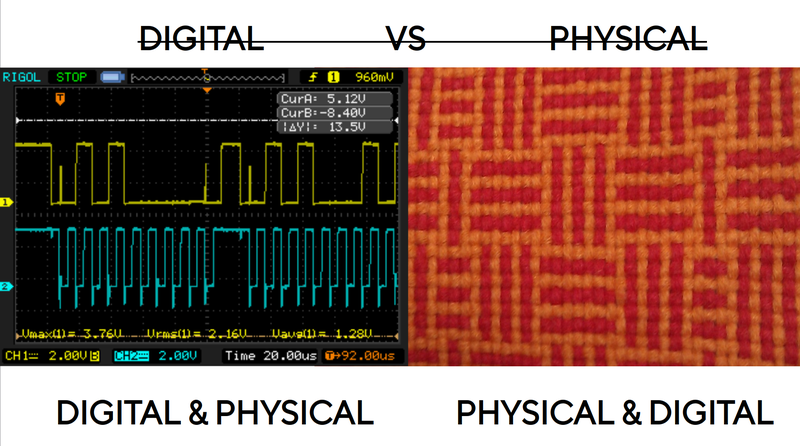
However, digital electronic communications are constrained by the same physical laws as woven patterns - because they are all part of the "real world", bound by physical laws and subject to the same properties of information theory such as entropy. One of the clearest ways to see this in weaving is the ability it has to travel over great distances (through time) with minimal data loss - a key feature of digital information. The material itself may degrade significantly, but archaeologists can "read" a fabric to determine the algorithm used to create it (the movements made by the weaver hundreds or thousands of years ago). With these algorithms, it's possible to create exact digital copies - including all the mistakes or in the moment decisions the weaver made, all that time ago.
In order to add to Alpaca's "Algorithmic Pattern Catalogue" we have built an online simulation for tablet weaving with a small language that describes the algorithmic movements for the simulator (or yourself) to follow to recreate these ancient patterns.
Pattern from the Oseberg ship burial, Vestfold, Norway circa 834 AD

This pattern is an extremely elegant, and comes from this useful source. It's designed for Viking mass production - as once set up it just involves rotating the cards continuously in the same direction to make this pattern. During weaving all you need to do is turn a single tablet can 180 degrees (the two rotate-backs below) to alter the pattern to a slightly different variation.
;; first warp with yellow and black threads, using s and z to specify initial twist direction
(warp
(y y y y) z
(y y y y) s
(y y y y) z
(b b b b) s
(y y y b) z
(b y b y) z
(y b y y) z
(b b b b) s
(y y y y) z
(y y y y) s)
(weave-forward 24) ;; produce fabric for 24 quarter turns forwards
;; turn tablet 4 twice to make a 180 degree change
(rotate-back 4)
(rotate-back 4)
;; now weave this new configuration
(weave-forward 24)
Viking band circa 800 AD excavated from the Swedish island of Björkö

Another Viking example (they really liked their tablet weaving). Twisting the tablets while weaving essentially reverses their direction when you turn them. This changes the uppermost warp thread colours to create pattern - and also alters the diagonal angle of the braid, which is unique to tablet weaving, and used to enhance the pattern.
;; warp all 10 tablets the same (black green white white)
(quick-warp 10 b g w w)
(warp-twist z z z z z z z z z z) ;; set initial twist
(warp-rotate 0 1 2 3 0 1 2 3 0 1) ;; set initial rotation in number of turns
(repeat 6
(twist 0 1 2 3 4 5 6) ;; twist these tablets
(weave-back 2)
(twist 5 6)
(weave-back 2)
(weave-forward 2)
(twist 3 4)
(weave-forward 2)
(twist 0 1 2))
Bronze/Iron age pattern from the salt mines of Hallstatt, circa 800 - 400 BC

I find it somehow interesting that the most complex patterns can be the oldest - this is just a small section of a larger weave, and one that required new bits to be added to the language. This pattern also includes what at first seemed like small mistakes to me, but may in fact just be tweaks that don't change the visual pattern but make the fabric stronger.
(warp
(y y g g) s
(y g g y) s
(y y g g) s
(y g g y) s
(g g y y) s
(g y y g) s
(y y g g) s ;; -- centre tablet
(g y y g) s
(g g y y) s
(g y y g) s
(y y g g) s
(g y y g) s
(y y g g) s)
(weave-back 1) ;; gets the tablets in the right starting position (should fix above)
;; squint and you might be able to see the underlying logic here with the pattern of f's and b's
(repeat 3
;; weave each card forward or back
(weave f f b b b b f f b b b f f f)
(weave f f b b b f f b b b b f f f)
(weave b f b b f f b b b b b f f f)
(weave f b b f f b b b b b b f f f)
(weave b b f f b b b b b b b f f f)
(weave b f f b b f f f b b b f f f)
(weave f f b b b f f f b b b f f f)
(weave f b b b b f f f b b b b b f)
(weave b b b b b f f f b b b b b f)
(weave b b b b b f f f b b b b b f)
(weave b b b b b f f f b b b b f f)
(weave f f b b b f f f b b b f f f)
(weave f f b b b f f f b b f f b f)
(weave f f b b b b b b b f f b b f)
(weave f f b b b b b b f f b b f f)
(weave f f b b b b b f f b b f b f))
You can find all these patterns and more (and you can add your own to our catalogue if you wish) on the online simulation which we'll be updating with other types of weaving in the future.

